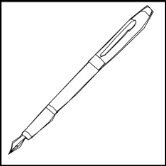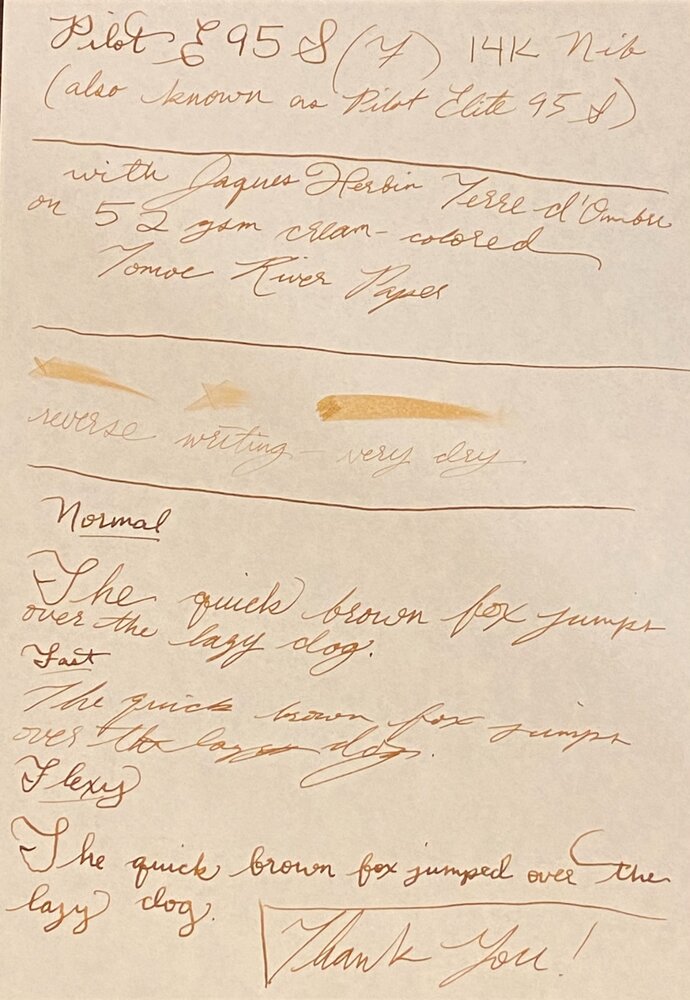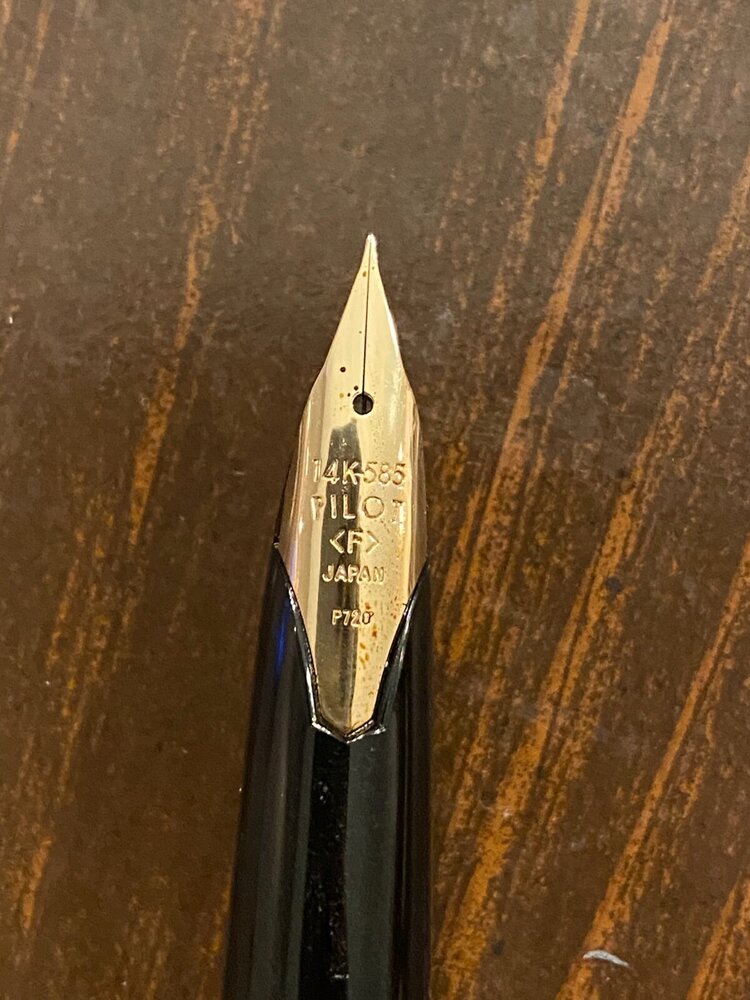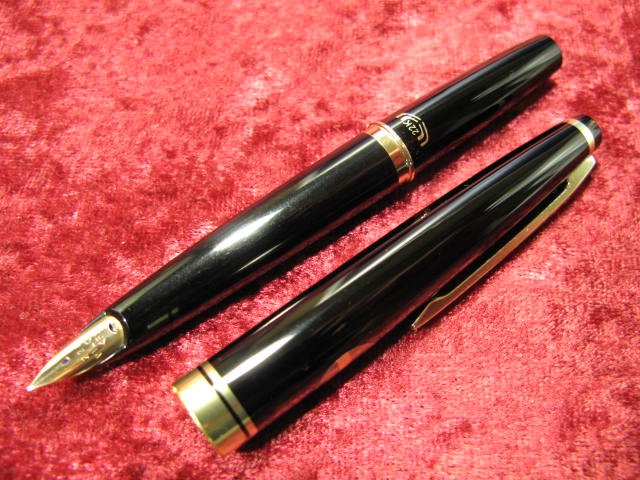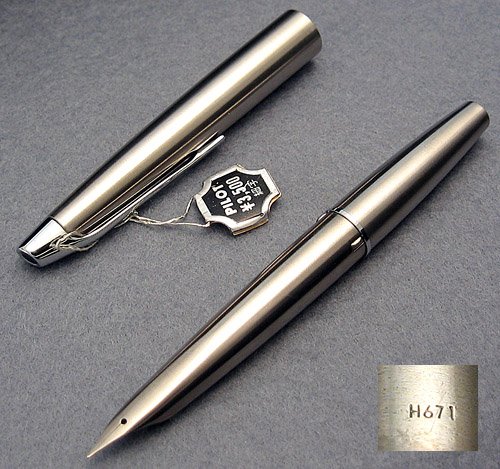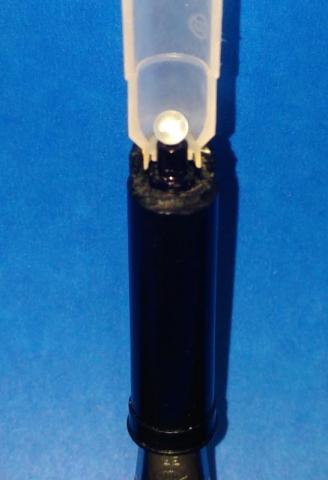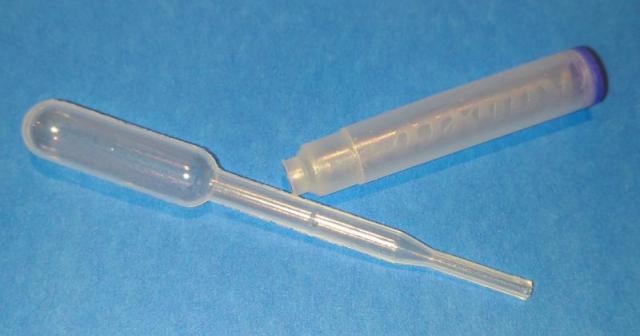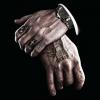Search the Community
Showing results for tags 'pocket pens'.
-
Hello! First of all, this is only my third review on FPN, so if you can please leave constructive criticism below! I would love to improve the quality of my reviews. The Pilot E95S seems to be like the least expensive gold nib pen that is consistently offered here in the U.S. . The only cheaper one I can think of is the Platinum PTL-5000A, which I would love if it was consistently offered in the U.S., but they seem to constantly discontinue it. So, this is a very popular first gold nib pen. It was my second gold nib, so I did get it relatively early in my fountain pen hobby. For a quick summary of the review, I like this pen. I don’t love it, but it’s is great value, and I definitely recommend it. Design and Build Quality (8.5/10) For the most part, this design is great. It is slim, but comfortable, has a great inlaid nib (which I love), is compact, but bigger when posted, and the feeling of capping and uncapping is great. But, Pilot’s black resin does not hold up to the little metal things on the inside of the cap that hold it on. It has fine scratches on it, which are pretty apparent. Now, I am one of those people who sort of like that, and don’t really want pens to look brand new, I want them to look like I used them. But I can understand how this can annoy some people. That’s why it’s a 8.5/10, instead of a 10/10. Nib Performance and Writing Experience (9/10) This nib is great. I have a fine nib, which is 14k gold and inlaid. It is smooth, and quite soft. I would call this a flex, semi-flex, or soft nib, but a quite soft nib. By that I mean that you can get some line variation, but not that much where you can use it for calligraphy, just a bouncy writing experience. The only thing is it is just a bit particular with inks. Both Noodler’s Walnut and Diamine Chocolate Brown were just a bit too dry for it, and it had some skipping. But all Herbin, Jacques Herbin, and Iroshizuku work great with it from my experience. With them the pen is not especially wet, but I wouldn’t call it dry either. With the writing sample, I used Jacques Herbin Terre d’Ombre, which is currently my favorite ink but might be replaced by Robert Oster Caffe Crema when that ink sample gets to me, and on 52gsm cream Tomoe River Paper. Conclusion This a great pen, and a great value! I highly recommend it. It’s really great! Little Note- It seems like every place I go to except for JetPens sells it as the Pilot E95S for $136, but JetPens sells it as the Pilot Elite 95S for $136 as well. Just a little thing. Edit- It was to commemorate the 95th anniversary of Pilot, but is not a limited edition. It also comes with the Pilot CON-40, but can fit the discontinued CON-20. Now the pictures: The second to last photo shows scratches on the barrel, and the last one shows the metal things on the inside of the cap.
- 36 replies
-
- pilot
- pocket pens
-
(and 8 more)
Tagged with:
-
When Summer arrives, my wardrobe shifts to Hawaiian shirts and polos. These usually have very shallow breast pockets that do not accommodate full-sized pens. So, for my everyday carries, I switch to pocket pens. Here is a sampling of my favorites: From Left to Right: Pelikan M800 (for sense of scale); Kaweco AL-Sport; Sailor PG Slim; Pilot Prera; Sailor PG Slim Mini; Franklin-Christoph Model 20p Am I the only one who carries different pens in different seasons? David
- 10 replies
-
- summer pens
- pocket pens
-
(and 1 more)
Tagged with:
-
I have been collecting writing instruments for a few decades and currently have about 300 of them in my collection. They are mostly vintage, and a few new ones. I try to follow technical evolution as themes of my collection such as filling mechanisms, nib characteristics, materials, etc. I recently became interested in pocket fountain pens and I really don`t have much knowledge about them, so I propose to start with what I know and perhaps members of the community can contribute. There are examples of writing instruments of the Victorian Era, that were meant to carry in pockets or pouches, such as telescopic mechanical pencils, dip pens or combination instruments. At the turn of the Century Safety fountain pens came about, in an attempt to prevent ink spillage when carried in a pocket or pouch. For the most part, these pens were of large size for a pocket. For the purpose of this discussion, I would like to propose the following definition. A pocket fountain pen is one that is short enough to fit in a pocket comfortably and by some means it is enlarged to become comfortable for writing. To my knowledge, there are to methods to achieve this purpose. 1 - Pens with a short barrel and long cap and long section. The threads of clutch ring where the cap engages with the barrel is at the end of the long section, so when capped they are short enough to pocket and when posted they become long enough to fit in the hand. 2 - Telescoping fountain pens. The first example of short barrel and long cap that I am aware of is the Kaweco Sport, that appeared in this format in the 1930's as a piston filled fountain pen with a matching mechanical pencil. Since the pencil doesn't require a cap, the concept doesn't apply to it and it ends up being just a short pencil. This pen is 4" capped and 5.5" posted. In the 1960's in Japan Sailor Pilot and Platinum started offering beautiful renditions of short / long fountain pens. The Japanese development of these pens is covered in depth in Richard Binder's e-book Japanese Pocket Pens. Below I show a Pilot Elite and a Pilot MYU from my collection. While telescopic dip pens where common in the late 19th Century, the first telescopic I am aware of is the Pilot telescopic fountain pen in the 1960's. There are probably earlier ones. In the mid 2000's, rOtring came out with telescoping fountain pens, mechanical pencils and ballpoints, the model Esprit Mini, which is currently produced by Parker. I am sure there is much more to this story than what I was able to present here.
- 22 replies
-
- pocket pens
- kaweco
-
(and 2 more)
Tagged with:
-
I really like Kaweco Liliput pocket pens – they are simple, robust and beautifully machined fountain pens. However, the Liliput’s small size mandates that ink cartridges need to used instead of a cartridge converter. I became frustrated with what I perceived as ink starvation when writing for extended periods of time with the pen, so I decided to look into this phenomenon in more detail. The picture below shows a cross-section view of the interface between the ink cartridge and the Kaweco (Bock) 060 nib. This 060 nib is used on all Kaweco fountain pens, except the Elite and Supra models. It shows that the plastic ball that originally sealed the ink cartridge sits nicely on top of the feed tube when the pen is orientated upright – which is the opposite of what’s desirable from an ink flow perspective. The feed tube length for the Kaweco (Bock) 250 nib (used on the Elite and Supra pens) extends about twice as far into the ink cartridge, so the mechanism for the plastic ball to obstruct the feed tube is largely mitigated for this design. My solution to this perceived problem is to prevent the plastic ball from being pushed into the cartridge. I use crimp pliers (i.e. smooth jaws) to squeeze the cartridge and eject the plastic ball from a new ink cartridge. Its a bit messy, but only needs to done when a replacement cartridge is required. I empty the cartridge and dry it out – then fill it with my favorite (Monblanc permanent blue) ink using a 0.2ml disposable transfer pipette. A photo of a (truly) empty ink cartridge and pipette is shown below. The 0.2ml pipette is small enough to be inserted into the ink cartridge, and represents a very compact and inexpensive approach to fill cartridges. I reuse the pipettes numerous times, so I have a lifetime supply from the minimum quantity of 200 that I bought from Amazon for about $20. If you find that you’ve experienced similar ink flow problems with your Kaweco cartridge pens, you may wish to consider the above approach to hacking the Kaweco cartridge interface.
-
They all look so good. Like a can of Pringles potato chips, you can't have just one. But if you could only choose one Japan - Asia pocket pen, which would you choose. Once you cast your vote, please take a few minutes and post why you choose the pen you did.
- 12 replies
-
- pocket pens
- just one
-
(and 2 more)
Tagged with:

